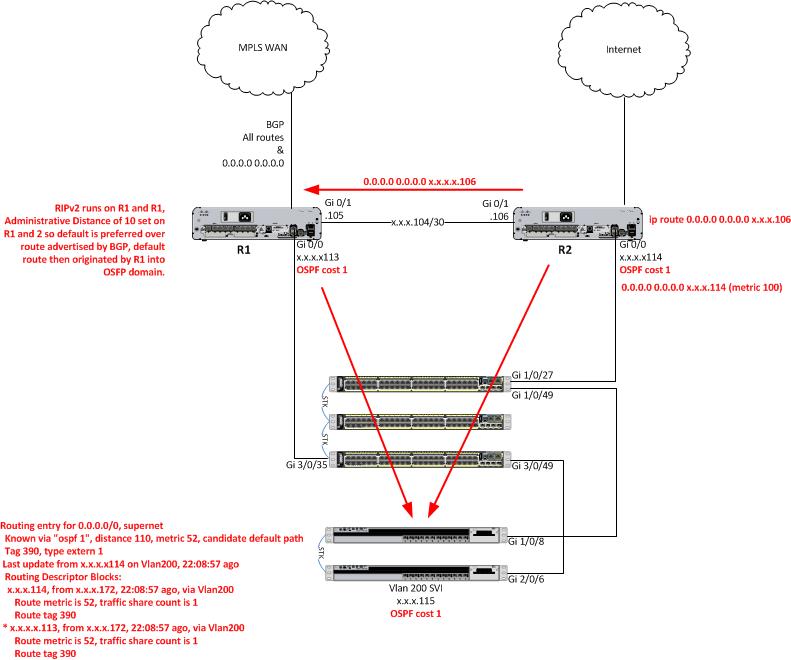- Cisco Community
- Technology and Support
- Networking
- Switching
- Query regarding OSPF?
- Subscribe to RSS Feed
- Mark Topic as New
- Mark Topic as Read
- Float this Topic for Current User
- Bookmark
- Subscribe
- Mute
- Printer Friendly Page
Query regarding OSPF?
- Mark as New
- Bookmark
- Subscribe
- Mute
- Subscribe to RSS Feed
- Permalink
- Report Inappropriate Content
05-30-2013 11:52 AM - edited 03-07-2019 01:39 PM
Hi all,
I've got this weird situation in work that I can't get my head around.....
We have two WAN routers. One is an MPLS router that is used to receive all routes from our WAN as well as a default, the routes are advertised via iBGP to router R1. To reduce the amount of Internet traffic going across the corporate WAN an ADSL service has been deployed. The ADSL also acts as a backup for the MPLS circuit so that if the MPLS circuit fails an IPSec tunnel is established over the Internet back into the corporate network.
I've attached a diagram that I hope will assist with the issue I am about to discuss.
R2 has a default route pointing to the Internet router. On R2 RIPv2 is configured to advertise this default to R1 (historical reasons) and is configured with an Administrative Distance of 10 so this default is preferred over the BGP advertised default. R1 and R2 are also configured to use OSPF. On R2 the 'default-information originate metric 100' is enabled under the OSPF process. Under R1 the same command is used but with a metric of 50. The idea is that if R1 dies the alternate route to R2 will be used by .115.
The WAN routers patch into a stack of L2 switches, which are then connected to the L3 device. I know this isn't good practice, but this is legacy. An SVI is then used on the L3 switch to talk to the two WAN routers, the SVI is used as other devices (WAN optimisation) exist in the VLAN inline to the WAN routers.
The issue I have is that R1 is advertising a default route to .113 and well as a default route to .114 with the same metric. This is seeing traffic being load balanced by the router which isn't desirable. I was hoping to see that traffic would only route over .113 until this router fails when it should route over .114.
Any idea why R1 is advertising both routes with the same metric?
In the design .115 is the DR, and .144 is the BDR.

- Labels:
-
Other Switching
- Mark as New
- Bookmark
- Subscribe
- Mute
- Subscribe to RSS Feed
- Permalink
- Report Inappropriate Content
05-30-2013 02:26 PM
Ok, I can now simulate the problem in GNS3, as soon as I enable OSPF on the interfaces between R1 and R2 I receive the two default routes with an equal cost. If OSPF remains disabled on the interface I only receive the route with the metric of 50. Still can't figure out why though? Any ideas?
- Mark as New
- Bookmark
- Subscribe
- Mute
- Subscribe to RSS Feed
- Permalink
- Report Inappropriate Content
05-30-2013 03:08 PM
Done, I know what is happening. Just needed some time away from it. The default route is being advertised from R1 to R2 with a metric of 50, which is obviously better than 100, this is then being advertised to the core. To fix it I had to increase the ip ospf cost on the interface between the two routers. As soon as I did this the route went away
Discover and save your favorite ideas. Come back to expert answers, step-by-step guides, recent topics, and more.
New here? Get started with these tips. How to use Community New member guide
